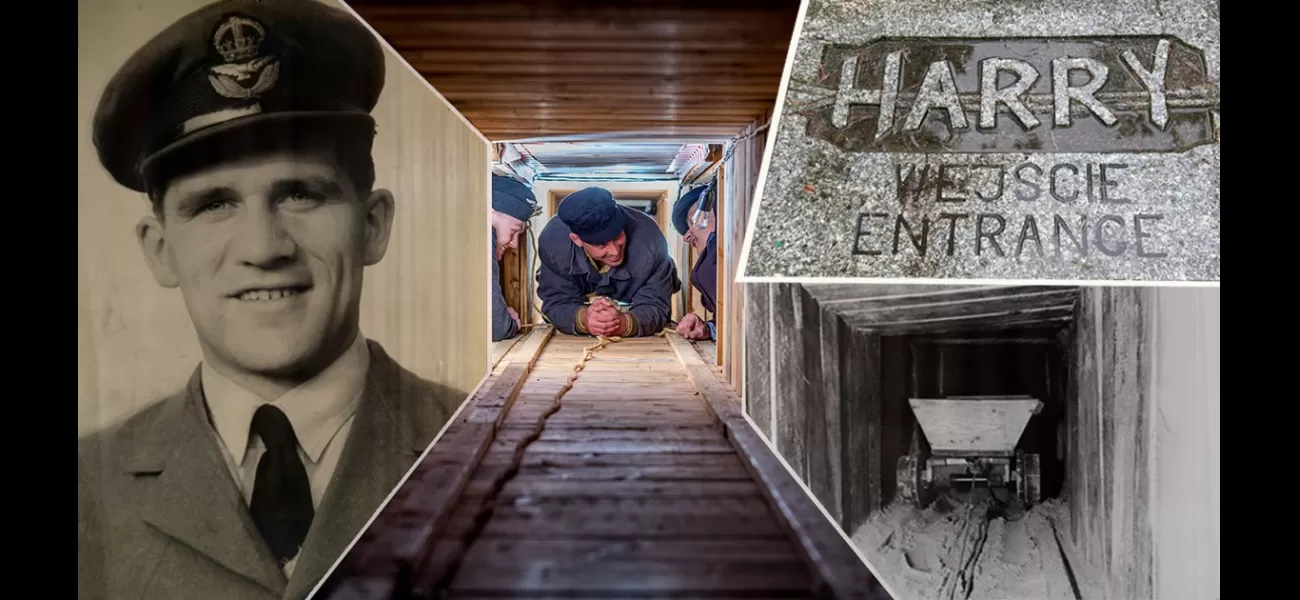The real-life events of the Great Escape during World War II, which served as the inspiration for a popular movie.
50 prisoners were shot during the notorious escape, which resulted in more harsh treatment for those who fled.
March 24th 2024.

The Great Escape was more than just a movie. It was a story that captured the imagination of filmmakers and audiences alike, and it had a major impact on World War II. Starring the iconic Steve McQueen, it quickly became one of the highest-grossing films of 1963 and has since been cemented as a true classic.
While the film was based on a true story, some historians have raised concerns about its historical accuracy. Despite its 94% score on Rotten Tomatoes and inclusion in the British Film Industry's '10 great prisoner of war films' round-up, there are some discrepancies between the movie and the real events. So, on the 80th anniversary of the real-life Great Escape, let's take a closer look at what actually happened and how the film differs from reality.
To get a better understanding, we spoke with Jem Duducu, a historian and presenter of the Condensed Histories podcast. He explained that the Great Escape was not an isolated incident, but rather one of many escape attempts from prisoner of war camps during World War II. In fact, it's estimated that around 35,000 Allied prisoners managed to escape from various prisons throughout the war. This became such a problem for the Nazis that they even built Colditz prison, which was supposed to be 'inescapable' and was designed to hold repeat offenders.
According to Jem, the film is "a strange mixture of fastidious creation and pure Hollywood fantasy." While some elements are 100% accurate, others were completely fabricated for the sake of creating "amazing cinema." For example, Steve McQueen's character represents a composite of several real men, and there was actually only one American involved in the real Great Escape.
So, when did the Great Escape take place and how did it happen? On March 24, 1944, 600 Allied airmen staged a mass breakout from Stalag Luft III, a prison camp run by the Luftwaffe in south-east Germany. The operation had been in the works for months, with prisoners digging three large tunnels under different huts within the camp. These tunnels, nicknamed 'Tom', 'Dick', and 'Harry', were 30ft deep and were designed to run for over 300ft before opening up in the nearby woodland.
To make their escape possible, the prisoners had to be resourceful and steal or barter for equipment. They used wood to line the tunnels, installed a railway and electric lighting, and even had primitive air conditioning for ventilation. All of this was done in secret, and the entrance to 'Harry' was cleverly disguised inside one of the POW huts.
According to German reports, the prisoners used a variety of items stolen from the camp, including bed boards, blankets, chairs, and even 30 shovels. However, only one of the tunnels, 'Harry', was completed and used for the actual escape. On the night of March 24, 1944, 76 RAF officers successfully broke out of the camp through 'Harry'. Unfortunately, the majority of them were recaptured, and 50 were ultimately shot by the Gestapo. Only three managed to successfully escape and avoid capture.
Jem commented on the tragic outcome of the Great Escape, saying, "It infamously led to 50 men being shot and resulted in even more brutality against escaped prisoners. Sadly, the Great Escape ultimately led to more death and misery than anything else."
So, what are some of the main inaccuracies in the film? According to the RAF Benevolent Fund, the movie is "true to the spirit of events in the north compound and the character of many of the men involved." However, as Jem pointed out, there was only one American prisoner involved in the real escape, and he was already a naturalized British citizen serving in the British Army. Despite these discrepancies, the film remains a beloved classic and a testament to the bravery and determination of the men involved in the Great Escape.
The Great Escape, a film featuring Steve McQueen, captured the hearts of filmmakers and left a lasting impact on World War II. It was released in 1963 and quickly became one of the highest-grossing films of the year, earning its place as a true classic in the eyes of many. Despite being based on a true story, some historians have pointed out its historical inaccuracies. However, it still boasts an impressive 94% score on Rotten Tomatoes and has been recognized by the British Film Industry as one of the top 10 prisoner of war films. But what were the actual events of the Great Escape 80 years ago, how does the film differ from reality, and what was its significance during World War II?
To answer these questions, The Agency spoke with Jem Duducu, a historian and host of the Condensed Histories podcast. He noted that throughout World War II, there were many escape attempts from prisoner of war camps, with an estimated 35,000 Allied prisoners successfully escaping various prisons. This became such a problem for the Nazis that they even created a prison specifically designed to be "inescapable" and hold repeat offenders: Colditz prison. Regarding the film itself, Jem described it as "a strange mixture of fastidious creation and pure Hollywood fantasy," with some elements being 100% accurate while others were fabricated for dramatic effect.
Steve McQueen played a starring role in the 1963 film, which is still considered one of the greatest war films ever made. However, in reality, there was only one American involved in the actual Great Escape. The mass breakout of Allied airmen from Stalag Luft III, a prison camp run by the Luftwaffe, took place on March 24, 1944. It involved 600 prisoners and had been in the works for months. Squadron Leader Roger Bushell initiated the operation and prisoners began digging three large tunnels, nicknamed "Tom," "Dick," and "Harry." These tunnels, which were over 30 feet deep and designed to run for more than 300 feet underground, were strategically placed under different huts within the camp and led to a wooded area outside.
The prisoners managed to acquire and repurpose various materials, such as bed boards, blankets, and shovels, to help them construct the tunnels and create makeshift lighting and ventilation systems. However, the first tunnel, Tom, was discovered by guards just before it reached the woods. The second tunnel, Dick, was abandoned and used for storage, leaving the prisoners to focus their efforts on the third and final tunnel, Harry. On the night of March 24, 1944, 76 RAF officers successfully escaped through Harry. Sadly, only three were able to make it to safety, as 73 were recaptured and 50 were shot by the Gestapo.
Despite the film's overall accuracy in depicting the construction of the tunnels, there are some notable inaccuracies. The RAF Benevolent Fund notes that the film captures the spirit of events and the character of the men involved, but there was only one American prisoner involved in the actual escape. This prisoner was already a naturalized British citizen and had been serving in the British Army. Jem explains that while the film is mostly accurate, it still contains some Hollywood embellishments.
In conclusion, the Great Escape may have captured the imagination of filmmakers and become a classic in its own right, but it's important to remember the real events and the sacrifices made by those involved. The mass breakout may have caused further brutality and tragedy, but it will forever be remembered as a testament to the resilience and determination of Allied prisoners during World War II.
While the film was based on a true story, some historians have raised concerns about its historical accuracy. Despite its 94% score on Rotten Tomatoes and inclusion in the British Film Industry's '10 great prisoner of war films' round-up, there are some discrepancies between the movie and the real events. So, on the 80th anniversary of the real-life Great Escape, let's take a closer look at what actually happened and how the film differs from reality.
To get a better understanding, we spoke with Jem Duducu, a historian and presenter of the Condensed Histories podcast. He explained that the Great Escape was not an isolated incident, but rather one of many escape attempts from prisoner of war camps during World War II. In fact, it's estimated that around 35,000 Allied prisoners managed to escape from various prisons throughout the war. This became such a problem for the Nazis that they even built Colditz prison, which was supposed to be 'inescapable' and was designed to hold repeat offenders.
According to Jem, the film is "a strange mixture of fastidious creation and pure Hollywood fantasy." While some elements are 100% accurate, others were completely fabricated for the sake of creating "amazing cinema." For example, Steve McQueen's character represents a composite of several real men, and there was actually only one American involved in the real Great Escape.
So, when did the Great Escape take place and how did it happen? On March 24, 1944, 600 Allied airmen staged a mass breakout from Stalag Luft III, a prison camp run by the Luftwaffe in south-east Germany. The operation had been in the works for months, with prisoners digging three large tunnels under different huts within the camp. These tunnels, nicknamed 'Tom', 'Dick', and 'Harry', were 30ft deep and were designed to run for over 300ft before opening up in the nearby woodland.
To make their escape possible, the prisoners had to be resourceful and steal or barter for equipment. They used wood to line the tunnels, installed a railway and electric lighting, and even had primitive air conditioning for ventilation. All of this was done in secret, and the entrance to 'Harry' was cleverly disguised inside one of the POW huts.
According to German reports, the prisoners used a variety of items stolen from the camp, including bed boards, blankets, chairs, and even 30 shovels. However, only one of the tunnels, 'Harry', was completed and used for the actual escape. On the night of March 24, 1944, 76 RAF officers successfully broke out of the camp through 'Harry'. Unfortunately, the majority of them were recaptured, and 50 were ultimately shot by the Gestapo. Only three managed to successfully escape and avoid capture.
Jem commented on the tragic outcome of the Great Escape, saying, "It infamously led to 50 men being shot and resulted in even more brutality against escaped prisoners. Sadly, the Great Escape ultimately led to more death and misery than anything else."
So, what are some of the main inaccuracies in the film? According to the RAF Benevolent Fund, the movie is "true to the spirit of events in the north compound and the character of many of the men involved." However, as Jem pointed out, there was only one American prisoner involved in the real escape, and he was already a naturalized British citizen serving in the British Army. Despite these discrepancies, the film remains a beloved classic and a testament to the bravery and determination of the men involved in the Great Escape.
The Great Escape, a film featuring Steve McQueen, captured the hearts of filmmakers and left a lasting impact on World War II. It was released in 1963 and quickly became one of the highest-grossing films of the year, earning its place as a true classic in the eyes of many. Despite being based on a true story, some historians have pointed out its historical inaccuracies. However, it still boasts an impressive 94% score on Rotten Tomatoes and has been recognized by the British Film Industry as one of the top 10 prisoner of war films. But what were the actual events of the Great Escape 80 years ago, how does the film differ from reality, and what was its significance during World War II?
To answer these questions, The Agency spoke with Jem Duducu, a historian and host of the Condensed Histories podcast. He noted that throughout World War II, there were many escape attempts from prisoner of war camps, with an estimated 35,000 Allied prisoners successfully escaping various prisons. This became such a problem for the Nazis that they even created a prison specifically designed to be "inescapable" and hold repeat offenders: Colditz prison. Regarding the film itself, Jem described it as "a strange mixture of fastidious creation and pure Hollywood fantasy," with some elements being 100% accurate while others were fabricated for dramatic effect.
Steve McQueen played a starring role in the 1963 film, which is still considered one of the greatest war films ever made. However, in reality, there was only one American involved in the actual Great Escape. The mass breakout of Allied airmen from Stalag Luft III, a prison camp run by the Luftwaffe, took place on March 24, 1944. It involved 600 prisoners and had been in the works for months. Squadron Leader Roger Bushell initiated the operation and prisoners began digging three large tunnels, nicknamed "Tom," "Dick," and "Harry." These tunnels, which were over 30 feet deep and designed to run for more than 300 feet underground, were strategically placed under different huts within the camp and led to a wooded area outside.
The prisoners managed to acquire and repurpose various materials, such as bed boards, blankets, and shovels, to help them construct the tunnels and create makeshift lighting and ventilation systems. However, the first tunnel, Tom, was discovered by guards just before it reached the woods. The second tunnel, Dick, was abandoned and used for storage, leaving the prisoners to focus their efforts on the third and final tunnel, Harry. On the night of March 24, 1944, 76 RAF officers successfully escaped through Harry. Sadly, only three were able to make it to safety, as 73 were recaptured and 50 were shot by the Gestapo.
Despite the film's overall accuracy in depicting the construction of the tunnels, there are some notable inaccuracies. The RAF Benevolent Fund notes that the film captures the spirit of events and the character of the men involved, but there was only one American prisoner involved in the actual escape. This prisoner was already a naturalized British citizen and had been serving in the British Army. Jem explains that while the film is mostly accurate, it still contains some Hollywood embellishments.
In conclusion, the Great Escape may have captured the imagination of filmmakers and become a classic in its own right, but it's important to remember the real events and the sacrifices made by those involved. The mass breakout may have caused further brutality and tragedy, but it will forever be remembered as a testament to the resilience and determination of Allied prisoners during World War II.
[This article has been trending online recently and has been generated with AI. Your feed is customized.]
[Generative AI is experimental.]
0
0
Submit Comment





